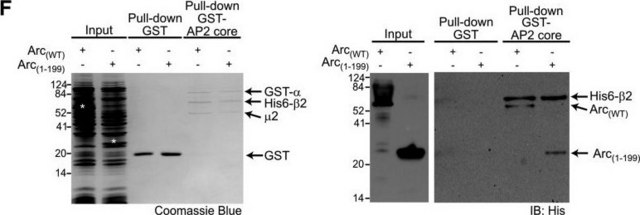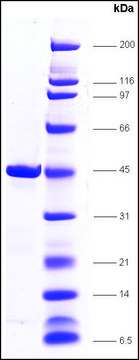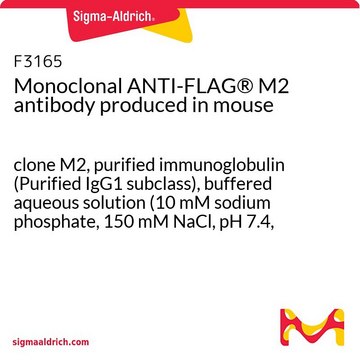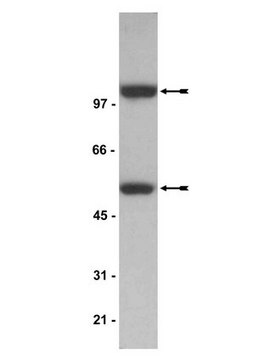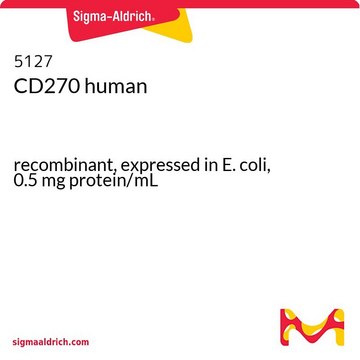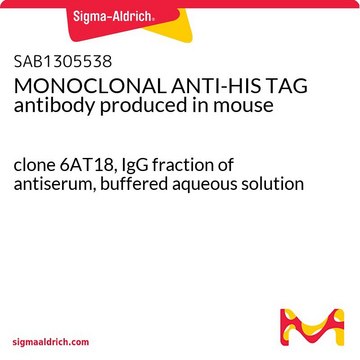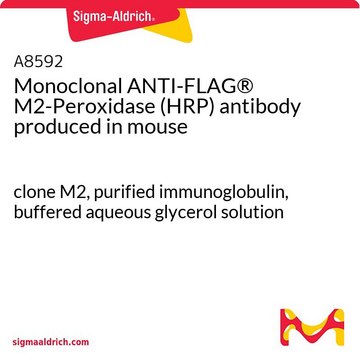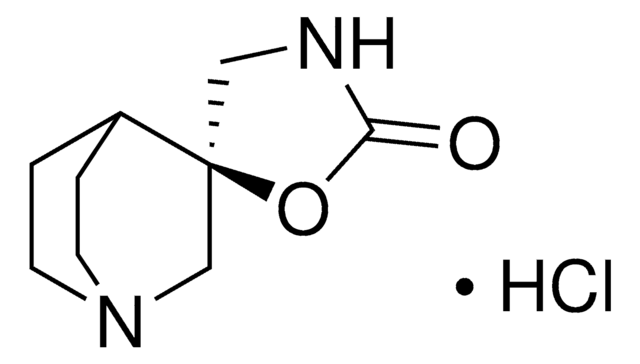推荐产品
生物来源
human
重组
expressed in Hi-5 Insect cells
方案
≥98% (HPLC)
≥98% (SDS-PAGE)
表单
lyophilized
效能
1.3-1.9 μg/mL
分子量
44.3 kDa
包装
pkg of 100 μg
技术
cell culture | mammalian: suitable
杂质
<0.1 EU/μg endotoxin, tested
颜色
white to off-white
UniProt登记号
运输
wet ice
储存温度
−20°C
基因信息
human ... TNFRSF14(8764)
一般描述
HVEM belongs to the TNF Receptor superfamily of transmembrane proteins and plays a role in the activation of T-cells and other lymphocytes. It is expressed in various cells and tissues including spleen, thymus, lung, macrophages, and T-cells. HVEM activation induces a signaling cascade which results in induction of transcription factors NF-kappaB and AP-1. LIGHT (TNFSF14) and TNF-beta (TNFSF1) function as the ligands for HVEM, which can also bind specifically to herpes simplex virus glycoprotein D. Soluble HVEM can act as a "receptor decoy" resulting in inhibition of the activity of the HVEM ligands, LIGHT and TNF-beta. Recombinant human HVEM-Fc Chimera is a 376 amino acid fusion protein containing an N-terminal domain corresponding to the extracellular region of HVEM and a C-terminal domain corresponding to residues 102 to 330 of human IgG1.
生化/生理作用
HVEM belongs to the TNF Receptor superfamily of transmembrane proteins and plays a role in the activation of T-cells and other lymphocytes. Recombinant human HVEM-Fc Chimera is a 376 amino acid fusion protein containing an N-terminal domain corresponding to the extracellular region of HVEM and a C-terminal domain corresponding to residues 102 to 330 of human IgG1.
序列
LPSCKEDEYP VGSECCPKCS PGYRVKEACG ELTGTVCEPC PPGTYIAHLN GLSKCLQCQM CDPAMGLRAS RNCSRTENAV CGCSPGHFCI VQDGDHCAAC RAYATSSPGQ RVQKGGTESQ DTLCQNCPPG TFSPNGTLEE CQHQTKRSCD KTHTCPPCPA PELLGGPSVF LFPPKPKDTL MISRTPEVTC VVVDVSHEDP EVKFNWYVDG VEVHNAKTKP REEQYNSTYR VVSVLTVLHQ DWLNGKEYKC KVSNKALPAP IEKTISKAKG QPREPQVYTL PPSRDELTKN QVSLTCLVKG FYPSDIAVEW ESNGQPENNY KTTPPVLDSD GSFFLYSKLT VDKSRWQQGN VFSCSVMHEA LHNHYTQKSL SLSPGK
外形
Lyophilized from 1x PBS, pH 7.2.
重悬
Centrifuge the vial prior to opening. Reconstitute in water to a concentration of 0.1- 1.0 mg/ml. Do not vortex. This solution can be stored at 2-8°C for up to 1 week. For extended storage, it is recommended to further dilute in a buffer containing a carrier protein (example 0.1% BSA) and store in working aliquots at -20°C to -80°C.
储存分类代码
11 - Combustible Solids
WGK
WGK 3
闪点(°F)
Not applicable
闪点(°C)
Not applicable
法规信息
新产品
Helene Baribault et al.
Expert opinion on therapeutic targets, 18(11), 1253-1264 (2014-10-08)
Although the human genome encodes ∼ 20,000 protein-coding genes, only a very small fraction of these have been explored as potential targets for therapeutic development. The challenge of identifying and validating new protein targets has contributed to the significant reduction
R I Montgomery et al.
Cell, 87(3), 427-436 (1996-11-01)
We identified and cloned a cellular mediator of herpes simplex virus (HSV) entry. Hamster and swine cells resistant to viral entry became susceptible upon expression of a human cDNA encoding this protein, designated HVEM (for herpesvirus entry mediator). HVEM was
B S Kwon et al.
The Journal of biological chemistry, 272(22), 14272-14276 (1997-05-30)
The tumor necrosis factor receptor (TNFR) superfamily consists of approximately 10 characterized members of human proteins. We have identified a new member of the TNFR superfamily, TR2, from a search of an expressed sequence tag data base. cDNA cloning and
L Yang et al.
Cell death & disease, 5, e1211-e1211 (2014-05-09)
ErbB2, an important membrane-bound receptor tyrosine kinase, was discovered nearly 30 years ago, but a natural ligand has never been found previously. ErbB2 is also an important oncogene and anticancer target, and its overexpression in cancer is associated with poor
Kenichiro Ito et al.
Nature communications, 6, 6373-6373 (2015-03-12)
Hepatocyte growth factor (HGF) receptor, also known as Met, is a member of the receptor tyrosine kinase family. The Met-HGF interaction regulates various signalling pathways involving downstream kinases, such as Akt and Erk. Met activation is implicated in wound healing
我们的科学家团队拥有各种研究领域经验,包括生命科学、材料科学、化学合成、色谱、分析及许多其他领域.
联系技术服务部门